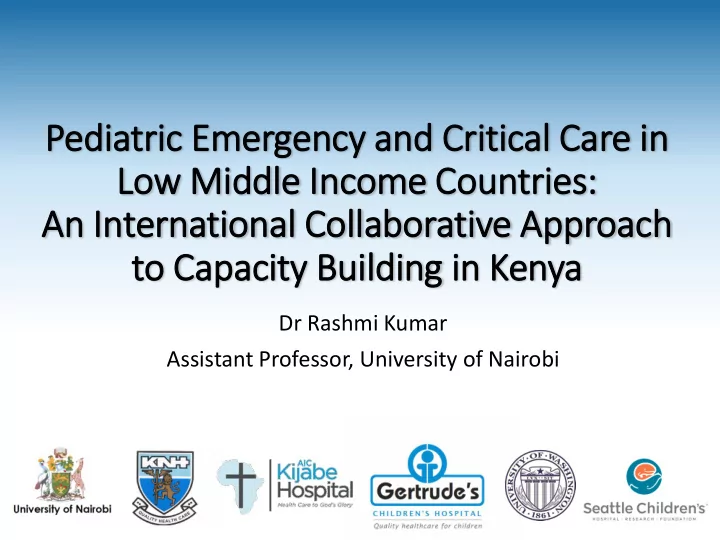

Pediatric Emergency and Cri ritical Care in in Low Mid iddle In Income Countries: An In International Coll llaborative Approach to Capacity Buil ilding in in Kenya Dr Rashmi Kumar Assistant Professor, University of Nairobi
The Need • 90% of global pediatric • The majority of these mortality and critical deaths occurs in sub- illness occurs in resource- Saharan Africa and is due poor settings, with a daily to preventable and under-five mortality of treatable illnesses. 17,000.
Pediatric Emergency and Critical Care in LMICs • 87% of inpatient deaths occur within the first 24 hours of admission • Advances in early recognition and effective management of critical illness are crucial. • Specialised Pediatric Emergency and Critical Care are crucial gaps in training & care
The current situation • Kenya has three trained Pediatric intensivists serving a population of 17 million children. • There are no Kenyan-born Pediatric Emergency Medicine sub-specialists in the country. • The African continent has only two training centers in Pediatric Critical Care; none in Pediatric Emergency Medicine.
Pediatric Emergency and Critical Care-Kenya (PECC-Kenya) • Recognizing the urgent need for a Pediatric Emergency and Critical Care training program to serve the region, we built a global partnership to fill the educational gap. • Built on prior relationships, the University of Nairobi (UoN) and Gertrude’s Children’s Hospital (GCH) in Kenya approached the University of Washington/Seattle Children’s to help develop a fellowship training program in Pediatric Emergency and Critical Care in Kenya.
PECC-Kenya Mission and Vision • A core group of Kenya- and Seattle- based pediatric emergency and critical care specialists formed in 2012-13 and determined the PECC-Kenya partnership’s mission: • To improve the management and outcomes of critically-ill children in sub-Saharan Africa through education, research, advocacy, service, and effective global partnerships.
PECC-Kenya Fellowship Development • Many collaborative meetings over the years structured the fellowship • A detailed fellowship curriculum based on local needs and resources was developed with key experts during a 2-day workshop in Nairobi • Representatives from the Kenyan Paediatric Association and Ministry of Health solidified fellowship content, structure and goals.
PECC-Kenya Fellowship • UoN, Kenyatta National Hospital, AIC Kijabe Hospital and GCH will offer a • Joint 2-year fellowship program in Pediatric Emergency and Critical Care providing a UoN certificate in PECC. • Experience/training in public and private, urban and rural healthcare settings, • Leadership, project management and implementation science training
Goals of PECC-Kenya • Healthy partnerships, respect for local human resource and culture, and an in-depth understanding of resource-poor settings. • Program commencement Sept 2017 • Monthly visiting specialists in the 3 initial years of program operation to supplement local trainers, helping long-term program sustainability.
Goals of PECC-Kenya • 3 fellows per year • 6 graduates by 2020, core faculty for future trainees • 36 graduates by 2030 working throughout Kenya and other East African countries • Ultimately the program to become self-sustainable and run by local faculty. • PECC-graduates transforming their local healthcare systems for better outcomes in critical illness.
Challenges of PECC-Kenya • Academic recognition of “fellowship” training • very few pediatric fellowships currently recognized in Kenya (pediatric endocrine, anesthesia, surgery) • Sustainable funding for capacity building programs • Outcome data of pediatric critical care and emergency interventions in limited resource settings needed to proof the point • Small core faculty constantly overwhelmed by clinical duties – protected time impossible! • Local faculty attraction / retention to maintain consistent standards • Focused recruitment
Summary • The burden of critically-ill children in Low Middle Income Countries is disproportionately high. • Sustainable capacity building in critical care and emergency medicine is a slow, time-consuming, resource-intensive process. • To achieve beneficial results we need to combine local and global expertise, commitment, and support.
Thank you • For more information see www.pecc-kenya.org • Contact drash..or pecc@uw.edu
Recommend
More recommend